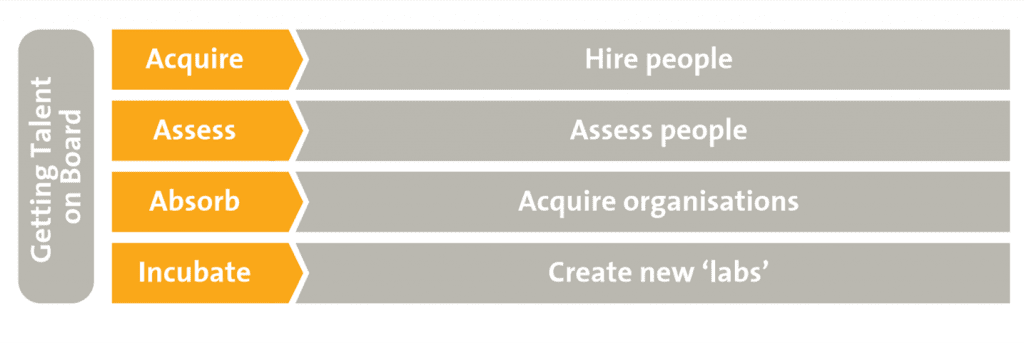The digital transformation has been launched in the enterprise, leadership has been established, the digital transformation is shaped and must now be driven forward. There might be appropriate talent already in the enterprise, but very often a gap of suitably skilled and experienced personnel is evident.
Bringing sufficient digital talent on board is paramount for the success of a digital initiative.
Talent is needed at different levels: Organisations often start with the ‘catalyst hire’ – the person who is going to change the world, for example a CDO hired from another organisation. Imagine they are the pebble tossed into the pond. They are the first ripple. The organisation will realise the determination of the executive team to push forward digitalisation when witnessing the advent of such high-ranking and experienced individuals. The catalyst hires are an important beacon of transformation, but they cannot do it alone. There are people above and below them who are also important (the next ripples on the pond).
The Board will need to have a mindset that allows this person to be successful – they are the ones who decide the risks the business can take and anything that is transformational is a risk. Careful attention must be given to the selection and bringing on board of such senior managers.
Next, the Board and the Chief Executive Officer (CEO) need to turn their attention towards the leadership team – most leaders today did not grow up in a digital era. Marketers grew up in a world of immeasurable branding spend, Chief Financial Officers (CFOs) grew up in a world where you bought technology, you did not rent it. CEOs grew up in a world without the constant focus of social media, without global communications in an instant.
The leadership team must immerse themselves in a digital world and become more digital, rather than fight the transformation that is coming.
Will the existing team be capable of not only undergoing but also propelling the digital transformation?
Preconditions to attract the right people: Everyone wants someone from Google, until they meet them and try and picture them working inside their organisation. People from Google (or Amazon, or Facebook, or eBay… the list goes on) have an incredible array of skills and experiences. However, most companies are not Google. And will never be Google.
Most companies have been successful in the past and need to transform in a changing environment. We have seen earlier that the existing business must be kept going while the digital transformation is underway. Careful balance is necessary.
Generally speaking, what organisations look for is someone who is ‘digital enough’. Do not mistake this for a lack of confidence or ambition. At each stage of a transformation journey, a different level of disruption is needed. Those starting their transformation need someone who can go from 0–20%. That profile is a mix of the old world and the new world. To go from 20–50% of the journey, you might need someone wholly from the new world to bring the organisation on the next step of the journey. Beyond 50%, digital leadership might already be provided from within the organisation by early movers in the digitalisation journey, by leaders who have visibly taken responsibility in transforming the enterprise.
How should the organisation approach the challenge of bringing digital talent on board during a digital transformation? We typically see four solutions, which are not always exclusive of each other, when organisations want to transform. Over time, most organisations will need to do all four to be genuinely successful. The key question is when to approach each.

- Hire people: Hiring different talent can accelerate transformation of the organisation by acquiring skills and experience that would not otherwise exist in the company. The culture of the company must be inclusive enough that these ‘different’ individuals do not experience tissue rejection. Hence, they need to be ‘digital enough’ in order to be able to bridge the divide between the classical and the digital business.
- Assess people: As the needs of the business shift, it is critical to understand what ‘good’ looks like in the new world. Your future leaders should be assessed against this framework, not the old-world framework – what made people successful in the ‘old world’ might not make them successful in the new world. Rethink the competencies that are needed in the new world. Hire and promote based on these.
- Acquire organisations: In the case of acquisitions during a digital transformation, it is critical to know what you are acquiring the organisation for. Organisations typically have four key assets: intellectual property, talent, brand and access to markets or clients. Planning for, and during, the acquisition, the organisation must be clear why they are acquiring and also put measures in place to keep those assets in position once the acquisitions are successful.
- Create new ‘labs’: A very common and often successful approach is to create a new entity, often outside the bureaucracy of the main organisation, which will own the digital innovation. This can immediately create a new culture with new thinking – but with the funding that start-ups can only dream of – to accelerate the process of digitalisation. The greatest single challenge of incubators is judging when they stop being ‘special’ and become absorbed more into the core business. If your new outpost is ‘too different’ from the core business, the journey to bring the people and the culture back into the organisation can be a long and painful one.
We have outlined above a portfolio of various approaches to getting the right talent into the enterprise. Once the new talent has been selected, an intense integration process starts to ensure from the outset that the new colleagues are effective in the new environment. Such integration is of paramount importance during the change management efforts of the digital transformation.
The new colleagues can also be the seed for the required culture change towards a digital future.

